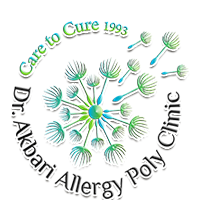“Allergic rhinitis” is the same as “seasonal or persistent allergy” or “hay fever”.
In this disease, the mucous membrane of the upper respiratory airways and nose is inflamed, which causes the affected person to suffer from sensitizing agents (allergens)
- sneeze
- Runny and stuffy nose
- Itchy eyes, throat and nose
- Watery and red eyes
- And in some cases the cough becomes prolonged.
Since the symptoms of allergic rhinitis are very similar to a cold, many patients mistakenly think that they have a cold in succession. When dealing with symptoms like these, how can we distinguish that the symptoms are related to allergic rhinitis and that we have not caught a cold? Chemical mediators There are certain substances such as “histamine” or “leukotrienes” in the body, which are released when exposed to “allergens” or sensitizing substances in the body of an allergic person and cause symptoms similar to a cold (sneezing, coughing, stuffy nose, runny nose and …). There are drugs that can stop the inflammatory action of these substances.
The symptoms of “allergic rhinitis” are very similar to the symptoms of “colds”, but there are some things that can distinguish these two diseases.
Differentiation between these two diseases is important because the treatment approach to them is different and the recommendations that the patient should take seriously in each case are not similar.
Viruses are the cause of cold or flu. Viruses are transmitted from the air we breathe and any close contact. Therefore, it is highly contagious and it is particularly important to follow tips such as frequent hand washing, covering the mouth and nose when sneezing and coughing, and not using shared equipment to prevent the spread of viruses.
If “seasonal sensitivity” is not contagious and depends on the genetic characteristics of the person and exposure to allergens such as smoke, plant pollen, drugs, chemicals and food, etc.
When a person catches a cold, in addition to symptoms such as a runny or stuffy nose, sneezing and coughing, they also experience “fever” and “body aches”.
A person with a cold usually suffers from weakness and lethargy.
“Allergic rhinitis” can cause concentration disorders. and learning especially in children.
In both cases, a person may experience a cold.
The pattern of “allergic rhinitis” is different.
It may be seasonal and due to the pollen of plants In the summer season due to the use of air conditioners and in the fall and winter season due to respiratory viruses.
If “allergic rhinitis” occurs due to air or chemical and food pollution, it may affect the patient throughout the year.
